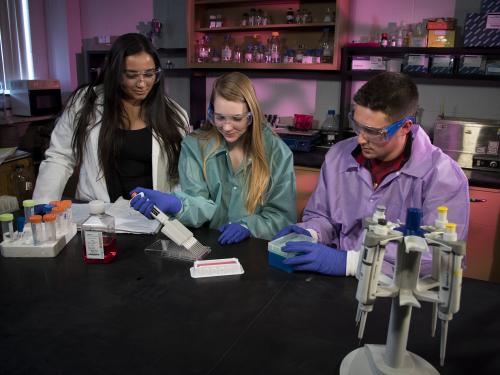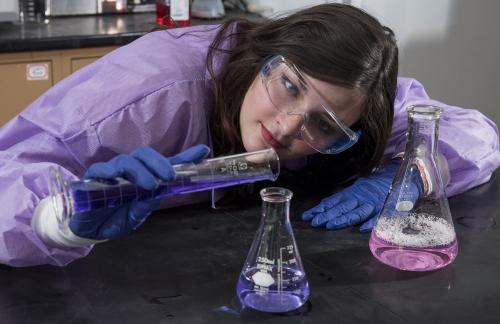University News
WIU Students Studying Aspects of Ovarian Cancer in University Laboratories
May 25, 2018
Learn more about WIU's Chemistry Program.
----
From the Spring 2018 issue of Western: The Magazine for Alumni of Western Illinois University
----
By Jodi Pospeschil
Research into the early detection, treatment and prevention of ovarian cancer is leading a group of Western Illinois University students to continue laboratory work started by their professor during her graduate education.
The research, with important medical implications, has also expanded to include other WIU faculty members and students, and has resulted in grant money awarded to help pay for needed equipment for University laboratories.
Assistant Chemistry Professor Mette Soendergaard completed her doctoral degree at the University of Missouri, conducting research on ovarian cancer cells in an effort to improve the ability to detect the aggressive cancer earlier. Soendergaard now runs a laboratory at Western that provides opportunities for graduate and undergraduate students to conduct a variety of research projects to better understand ovarian cancer factors.
Ovarian cancer is the fifth leading cause of cancer deaths among women and 80 percent of cases are diagnosed in the late stages. Because of the late detection, the survival rate in the later stages drops to about 45 percent.
There are a variety of studies being conducted in Soendergaard's Currens Hall laboratory, including one attempting to improve the ability to detect the cancer cells more easily. Under current practices, a pelvic ultrasound misses some positive cancer cases, making the process of an accurate diagnosis more invasive.
"It's targeted cancer imaging," explained WIU senior chemistry major Mallika Asar, of Lisle, IL, who is a member of one of the laboratory's research teams. "The screening methods for ovarian cancer are under investigation, because typically surgery is necessary for a diagnosis."
The study, by Asar and other Western students, introduces a "phage," or virus, which binds to the cancer cells, in an effort to detect the ovarian cancer cells. The students' research injects a specific phage into mice and studies its binding ability to healthy cells. Fluorescent intensity is used to examine the binding in more detail.
The mouse-related testing portion of the study is conducted at the University of Missouri.
Asar said she began her research with other academic pursuits in mind, but believes her experience in WIU's laboratories will help prepare her for the MCAT exam.
"I didn't intend to like research this much, but it's always changing and it's always something new," she said.
According to Soendergaard, the phage introduction is important for the detection and imaging of malignant tumors.
"Cancer imaging and detection is tremendously important when it comes to giving a patient lifesaving treatment," said Soendergaard. "Early detection of tumors significantly increases survival rates, and it is, therefore, crucial to identify new biomarkers and ligands specific to cancer cells."
A second study group, assisted by WIU Associate Professor of Biological Sciences Sue Hum-Musser and Biological Sciences Interim Chair Richard Musser, looks at cancer targeting peptides and how they target and bind to ovarian cancer, or ways ovarian cancer cells could be eradicated.
"We are excited to collaborate on this project and figure out the genetic expression of the treated cancer cells," said Hum-Musser. "Learning the pathways that are affected will help us understand the mechanisms involved in the cellular response. This information could be useful in developing diagnostic markers or treatment avenues."
WIU senior biology major Lindsey Weintraub, of Macomb, is one of the students working on this research project, which investigates how ovarian cancer cells adapt to chemotherapy, as well possible pharmaceutical treatments.
"I never met my grandmother because she died of ovarian cancer, so I have a genetic predisposition and I'm prone to it," said Weintraub. "I hope to go to veterinary school eventually and, with the increased competition for spots, this research work will help me stand out."
The next step for this project is to repeat the existing research study but introducing different incubation times.
Other studies in the WIU laboratory include some that look at the use of soybean secondary compounds for ovarian cancer prevention.
"There are bioactive compounds in soybeans and we are trying to see if they will inhibit cancer and increase the response of the immune system to cancer," Soendergaard added.
For many of the faculty and students involved in the various research projects, the studies have a personal component as many have lost loved ones to ovarian cancer. The research also crosses academic disciplines at WIU, including biology and chemistry.
The students involved in the various ovarian cancer research projects meet each Friday to discuss their work and results.
Soendergaard has authored and co-authored numerous articles about her research in academic journals. She said it's fulfilling to have students continue the research she began while working on her doctoral degree.
"As often happens when you get your Ph.D, you get to take a little bit of your research with you," she said.
Another important aspect of the University-based research is its connection to each of WIU's four core values: academic excellence, educational opportunity, personal growth and social responsibility.
Outside the University's laboratories, there are a variety of WIU-based programs to help with funding for the research and laboratory needs, including the Research Inspiring Student Excellence (RISE) program, the Women in Science program and the WIU College of Arts and Sciences. Grants from those programs are competitive and necessary for the enhancement of student research experiences.
Learn more about WIU's Chemistry Program.
Posted By: University Communications (U-Communications@wiu.edu)
Office of University Communications & Marketing



Connect with us: